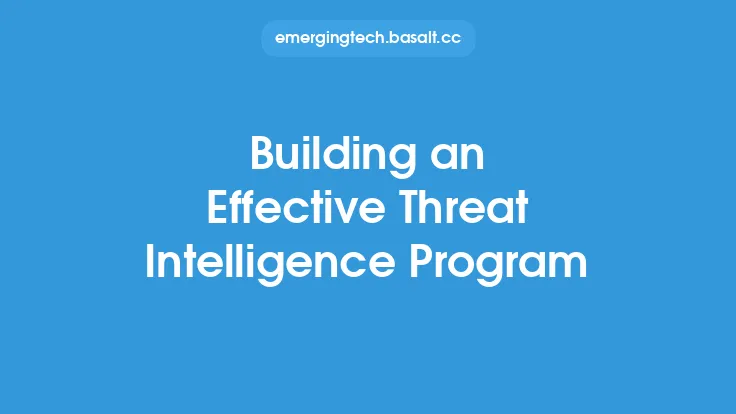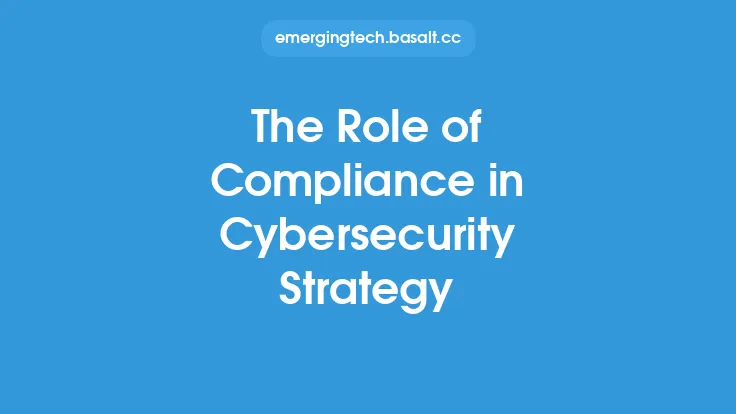Building a robust compliance program for cybersecurity is a critical component of any organization's overall security posture. Compliance programs are designed to ensure that an organization's cybersecurity practices and policies adhere to relevant laws, regulations, and industry standards. In today's complex and ever-evolving cybersecurity landscape, a well-structured compliance program is essential for protecting sensitive data, preventing cyber threats, and maintaining the trust of customers, partners, and stakeholders.
Introduction to Compliance Programs
A compliance program for cybersecurity typically consists of a set of policies, procedures, and controls that are designed to ensure that an organization's cybersecurity practices meet or exceed the requirements of relevant laws, regulations, and industry standards. Compliance programs are often mandated by regulatory bodies, such as the Payment Card Industry Data Security Standard (PCI DSS) for organizations that handle credit card information, or the Health Insurance Portability and Accountability Act (HIPAA) for organizations that handle protected health information. However, even in the absence of regulatory requirements, a compliance program can help an organization to establish a robust cybersecurity posture and reduce the risk of cyber threats.
Key Components of a Compliance Program
A comprehensive compliance program for cybersecurity should include several key components, including:
- Policies and procedures: Clear, concise, and well-documented policies and procedures that outline an organization's cybersecurity practices and expectations.
- Risk assessment and management: A systematic process for identifying, assessing, and mitigating cybersecurity risks.
- Training and awareness: Regular training and awareness programs to ensure that employees understand the importance of cybersecurity and their roles in maintaining a secure environment.
- Incident response: A well-defined incident response plan that outlines the steps to be taken in the event of a cybersecurity incident.
- Continuous monitoring: Ongoing monitoring and evaluation of an organization's cybersecurity posture to ensure that it remains effective and compliant with relevant laws and regulations.
- Audit and compliance: Regular audits and compliance reviews to ensure that an organization's cybersecurity practices are aligned with relevant laws, regulations, and industry standards.
Implementing a Compliance Program
Implementing a compliance program for cybersecurity requires a structured approach that involves several key steps, including:
- Conducting a risk assessment: Identifying and assessing the cybersecurity risks that are relevant to an organization's specific industry, size, and complexity.
- Developing policies and procedures: Creating clear, concise, and well-documented policies and procedures that outline an organization's cybersecurity practices and expectations.
- Establishing a compliance team: Assembling a team of individuals who are responsible for overseeing and implementing the compliance program.
- Providing training and awareness: Delivering regular training and awareness programs to ensure that employees understand the importance of cybersecurity and their roles in maintaining a secure environment.
- Implementing controls and countermeasures: Implementing technical, administrative, and physical controls and countermeasures to mitigate cybersecurity risks.
- Monitoring and evaluating: Continuously monitoring and evaluating an organization's cybersecurity posture to ensure that it remains effective and compliant with relevant laws and regulations.
Technical Controls and Countermeasures
Technical controls and countermeasures are a critical component of a compliance program for cybersecurity. These controls and countermeasures are designed to prevent, detect, and respond to cyber threats, and may include:
- Firewalls: Network devices that control incoming and outgoing network traffic based on predetermined security rules.
- Intrusion detection and prevention systems: Network devices that monitor network traffic for signs of unauthorized access or malicious activity.
- Encryption: The process of converting plaintext data into unreadable ciphertext to protect it from unauthorized access.
- Access control: Technical controls that regulate who has access to an organization's systems, data, and applications.
- Vulnerability management: The process of identifying, assessing, and mitigating vulnerabilities in an organization's systems and applications.
Administrative Controls and Countermeasures
Administrative controls and countermeasures are also an essential component of a compliance program for cybersecurity. These controls and countermeasures are designed to establish a culture of cybersecurity awareness and compliance within an organization, and may include:
- Security awareness training: Regular training programs that educate employees on the importance of cybersecurity and their roles in maintaining a secure environment.
- Incident response planning: The process of developing and implementing a plan to respond to cybersecurity incidents.
- Compliance training: Regular training programs that educate employees on the requirements of relevant laws, regulations, and industry standards.
- Background checks: The process of conducting background checks on employees and contractors to ensure that they are trustworthy and reliable.
Physical Controls and Countermeasures
Physical controls and countermeasures are a critical component of a compliance program for cybersecurity. These controls and countermeasures are designed to protect an organization's physical assets, such as servers, laptops, and mobile devices, from unauthorized access or theft. Physical controls and countermeasures may include:
- Access control: Physical controls that regulate who has access to an organization's facilities and equipment.
- Surveillance: The use of cameras and other monitoring devices to detect and prevent unauthorized access or activity.
- Asset tracking: The process of tracking and monitoring an organization's physical assets to prevent loss or theft.
- Secure storage: The use of secure storage devices, such as safes or locked cabinets, to protect sensitive data and equipment.
Maintaining Compliance
Maintaining compliance with relevant laws, regulations, and industry standards is an ongoing process that requires continuous monitoring and evaluation. Organizations must regularly review and update their compliance programs to ensure that they remain effective and compliant with changing regulatory requirements. This may involve:
- Conducting regular audits: Regular audits and compliance reviews to ensure that an organization's cybersecurity practices are aligned with relevant laws, regulations, and industry standards.
- Staying up-to-date with regulatory changes: Continuously monitoring regulatory changes and updates to ensure that an organization's compliance program remains current and effective.
- Providing ongoing training and awareness: Delivering regular training and awareness programs to ensure that employees understand the importance of cybersecurity and their roles in maintaining a secure environment.
- Continuously monitoring and evaluating: Continuously monitoring and evaluating an organization's cybersecurity posture to ensure that it remains effective and compliant with relevant laws and regulations.





